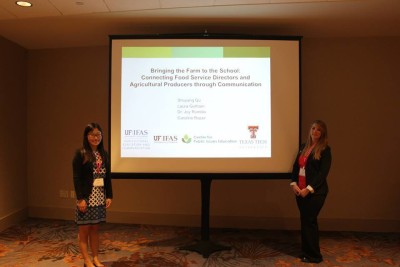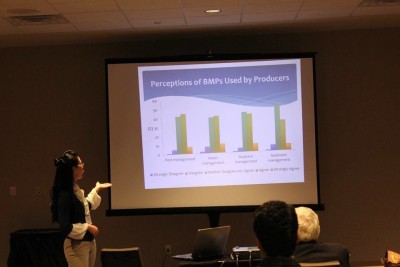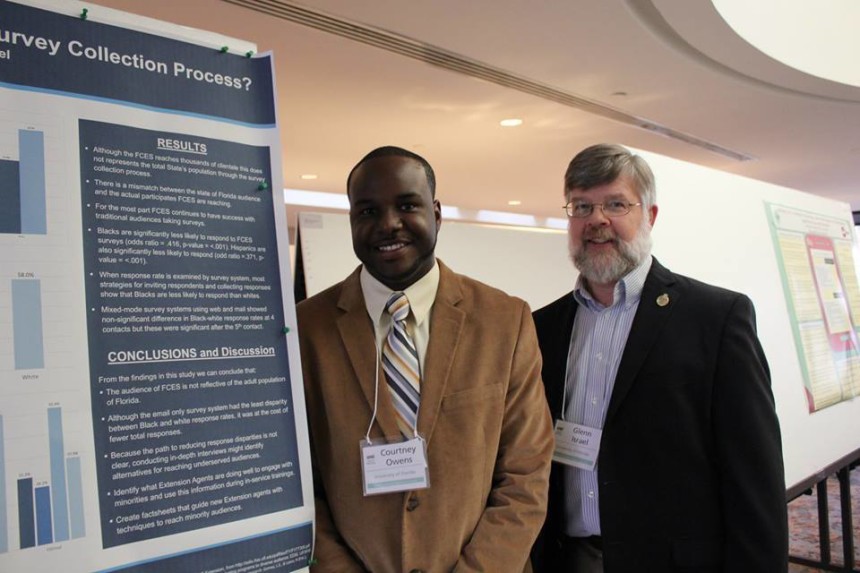By Shuyang Qu
A PIE Center research paper won the top agricultural communications research honors at the annual conference of the Southern Association of Agricultural Scientists.
Assistant professor Joy Rumble and master’s student Taylor Rumble collaborated to write “A Fresh Brand Strategy: Evaluating Consumers’ Strawberry Purchasing Intent and Their Attitude toward Florida Grown Strawberries,” which won the outstanding research paper award in the agricultural communications section.
 Twelve PIE Center faculty and graduate students attended the annual conference, including three students who have already graduated. They presented eight papers and a poster based on PIE Center research. In addition to research about the branding of Florida-grown strawberries, the presented research covered topics such as the public knowledge of current agricultural and natural resources issues, survey development methodology, strategies to connect local farmers to with school food service professionals, the public’s water use and perceptions, communication strategies for a successful extension programs and using heat maps as a tool to determine website usability.
Twelve PIE Center faculty and graduate students attended the annual conference, including three students who have already graduated. They presented eight papers and a poster based on PIE Center research. In addition to research about the branding of Florida-grown strawberries, the presented research covered topics such as the public knowledge of current agricultural and natural resources issues, survey development methodology, strategies to connect local farmers to with school food service professionals, the public’s water use and perceptions, communication strategies for a successful extension programs and using heat maps as a tool to determine website usability.
Papers
A Fresh Brand Strategy: Evaluating Consumers’ Strawberry Purchasing Intent and Their Attitude toward Florida Grown Strawberries
Taylor Ruth & Joy Rumble
This paper examined consumers’ purchasing intent and attitudes toward Florida strawberries to develop effective brand strategies. Consumers indicated a preference toward Florida strawberries and preferred to purchase strawberry packages with the Fresh from Florida logo on the label. Recommendations from this study included encouraging local strawberry growers to use the Fresh from Florida logo on their product to better market Florida strawberries and reinforce positive associations consumers already had with the fruit.
Determining the Viability of Visual Analogue Scales for Use When Conducting Agricultural and Extension Education Surveys
Keegan Gay, Taylor Ruth, Arthur Leal, Joy Rumble & Alexa Lamm,
This research examined the use of visual analogue scales in survey research in place of traditional Likert-type scales with radio buttons. The objectives in the paper compared means and attrition for the two scales as well as the frequency of respondents placing the slider in between scale points.
Analyzing Extension Agent Knowledge Levels and Needs Regarding Public Issues
Keegan Gay, Courtney Owens, Alexa Lamm & Joy Rumble
By determining the current level of knowledge and frequency of addressing contentious issues in  and natural resources, this research examined the perceived usefulness of different sources of information when extension agents are learning about contentious issues.
and natural resources, this research examined the perceived usefulness of different sources of information when extension agents are learning about contentious issues.
Bringing the Farm to the School: Connecting Food Service Directors and Agricultural Producers through Communication
Shuyang Qu, Laura Gorham, Joy Rumble & Caroline Roper
Through semi-structured interviews with producers and food service directors, producers and food service directors, researchers discussed the barriers identified with the Farm to School program as well as identified potential program enhancements for producers and food service directors alike.
Healthy Gulf, Healthy Communities: Community Leaders Identifying Needs and Strategies after a Disaster
Angela B. Lindsey
To serve communities affected by the 2010 Deepwater Horizon oil spill the best, the Healthy Gulf, Healthy Communities project formed a community advisory committee with 21 community representatives from government service agencies, nonprofit organizations, other community organizations and opinion leaders. Analysis revealed that group discussions led to the potential development of a formal regional network to support nonprofits and community resiliency.
Do Extension Audiences Behave in a Similar Manner? Exploring the Differences between the General Public and High Water Users
Pei-wen Huang, Alexa Lamm & Michael Dukes
This study sought to identify differences in water conservation behavior engagement between the general public and high-water users to facilitate the development of IFAS Extension programs targeting high-water users’ adoption of water conservation behaviors. Researchers surveyed Florida residents and a separate group of high-water users in the Orlando area for this descriptive and comparative study. Compared to the general public, high-water users reported a higher frequency of engagement in water use behaviors but were less likely to engage in water conservation and related societal behaviors.
Public Opinions of Farmer-oriented Environmentally Friendly Extension Programs: A Case of Best Management Practices
Pei-wen Huang, Alexa Lamm & Joy Rumble
This study sought to identify consumers’ perceptions of best-management practices and preferred communication channels to facilitate the development of farmer-oriented extension programs that assist with direct communication between farmers and consumers. Researchers surveyed residents in seven Florida counties for this descriptive study. The findings indicated the respondents either agreed or were undecided if farmers practice best-management practices properly, and the majority perceived farmers’ engagement in best-management practices as important. Further, the majority of the respondents held positive beliefs, attitudes, and trust toward farmers who fikkiw best-management practices.
Innovative Poster
Catching your Attention: Using Heat Maps to Determine the Usability of Websites
Laura Gorham, Shuyang Qu & Alexa Lamm
Heat maps, or graphical representations of how users interact with a website, allow organizations to gather information to help determine a website’s efficiency, performance and clarity. Organizations can use this information to improve communication strategies targeted toward website use and value.


















